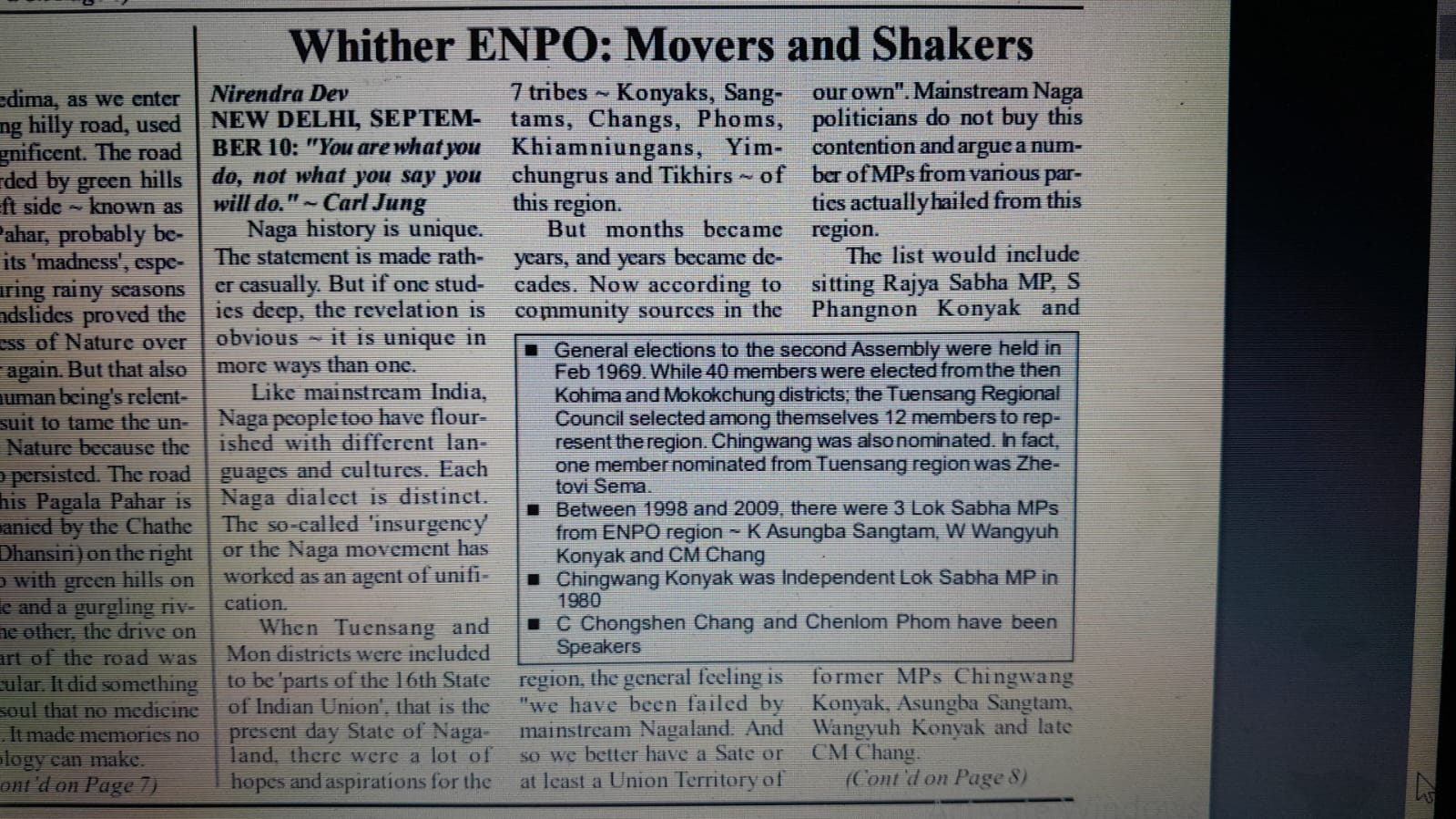** General elections to the second Assembly were held in Feb 1969. While 40 members were elected from the then Kohima and Mokokchung district; the Tuensang Regional Council selected among themselves 12 members to represent the region.
Veteran Chingwang Konyak was also nominated. In fact, one member nominated from Tuensang region was Zhetovi Sema.
New Delhi
“You are what you do, not what you say you will do.”
— Carl Jung
Naga history is unique. The statement is made rather casually. But if one studies deep, the revelation is obvious -- it's unique in more ways than one.
Like the mainstream India -- Naga people too have flourished with different languages and cultures. Each Naga dialect is distinct.
The so-called 'insurgency' or the Naga movement has worked as an agent of unification.
When Tuensang and Mon districts were included to be 'parts of the 16th state of Indian union', that is the present day state of Nagaland, there were a lot of hopes and aspirations for seven tribes from this region.
The tribes are - Konyaks, Sangtams, Changs, Phoms, Khiamniungans, Yimchungrus and Tikhirs.
But months became years, and years became decades -- now according to community sources in the region -- the general feeling is "we have been failed by mainstream Nagaland. And so we better have a state or at least a Union Territory of our own".
The mainstream Naga politicians do not buy this contention and argue a number of MPs from various parties actually hailed from this region.
The list would include sitting Rajya Sabha MP, S. Phangnon Konyak and former MPs Chingwang Konyak, Asungba Sangtam, Wangyuh Konyak and Late CM Chang.
These thoughts among the people nevertheless have led to the demand for Frontier Nagaland and the Eastern Nagaland People's Organisation (ENPO) are at the forefront of the battle.
Some years back, the students took the tough plunge and Eastern Nagaland Students' Federation (ENSF) dissociated
themselves from the apex and much influential Naga Students' Federation (NSF).
Here too, the NSF argument is that the apex students' body could not be blamed. On the contrary, some
mainstream politicians say several ENPO politicians could not come out of their 'NEFA mindset'.
Talk to a former student leader from that region. He throws up a one liner which seeks to make observers raise eyebrows on the perceived 'genuineness' of the demand by ENSF.
"Till the time ENSF got out of NSF, no Konyak or from other six tribes ever could become NSF president. Why?"
Similar questions can be thrown up as regards why not having a Chief Minister from the region. C Chongshen Chang became deputy chief minister under K L Chishi for a month and in the 1990s fierce politicking within top leaders the Congress party had denied Chingwang Konyak the chief ministership.
Chingwang Konyak was then Pradesh Congress chief and paradoxically in 2022 is heading the NDPP -- wherein the real strength of power, however, lies with an Angami old war horse and Chief Minister Neiphiu Rio.
One NDPP leader says : "We have enough respect for Chingwang Konyak and hence he is the party Chief....Do not forget Chingwang was also an eminent Minister and also Congress president once".
Casually, community leaders from Tuensang-Mon region (now having six districts) say -- while so far we have produced only one IAS officer and he is also heading a newly created department called Development of Under Developed Authority (DUDA).
The total number of gazetted officers among Konyaks could stand around 300.
This is with Konyaks -- whose estimated population is 2.5 lakh.
Sangtams and Changs would possibly make around 200 only.
"But on the other hand, there are some villages and blocks in Ao and Angami regions, the number of gazetted officers would be around 250-300," said one of them.
Well, if we come to education and fund allocation etc, here too, locals in the Tuensang-Mon region feel part of the fault line
lies with the authorities, chief ministers and ministers in 'far-off state capital Kohima'.
"Funds were allocated, but there was no proper monitoring. Corruption was encouraged and many ministers and top leaders from the ENPO region have invested in commercial hub of Dimapur or even in state capital Kohima," a source said.
In the education sector -- this journalist interacted with a native businessman; who says - "The Aos, the Assamese and even the Bengalis gave us education, and taught us. They opened our eyes; but when it came to implementation on ground and helping us by showing the roadmap into the future, they too did not deliver".
ends
Inset:
** General elections to the second Assembly were held in Feb 1969. While 40 members were elected from the then Kohima and Mokokchung district; the Tuensang Regional Council selected among themselves 12 members to represent the region. Chingwang was also nominated. In fact, one member nominated from Tuensang region was Zhetovi Sema.
## Between 1998 and 2009, there were three Lok Sabha MPs from ENPO region - K. Asungba Sangtam, W. Wangyuh Konyak and also C M Chang
$ Chingwang Konyak was Independent Lok Sabha MP in 1980
** C Chongshen Chang and Chenlom Phom have been Speakers
ends








No comments:
Post a Comment